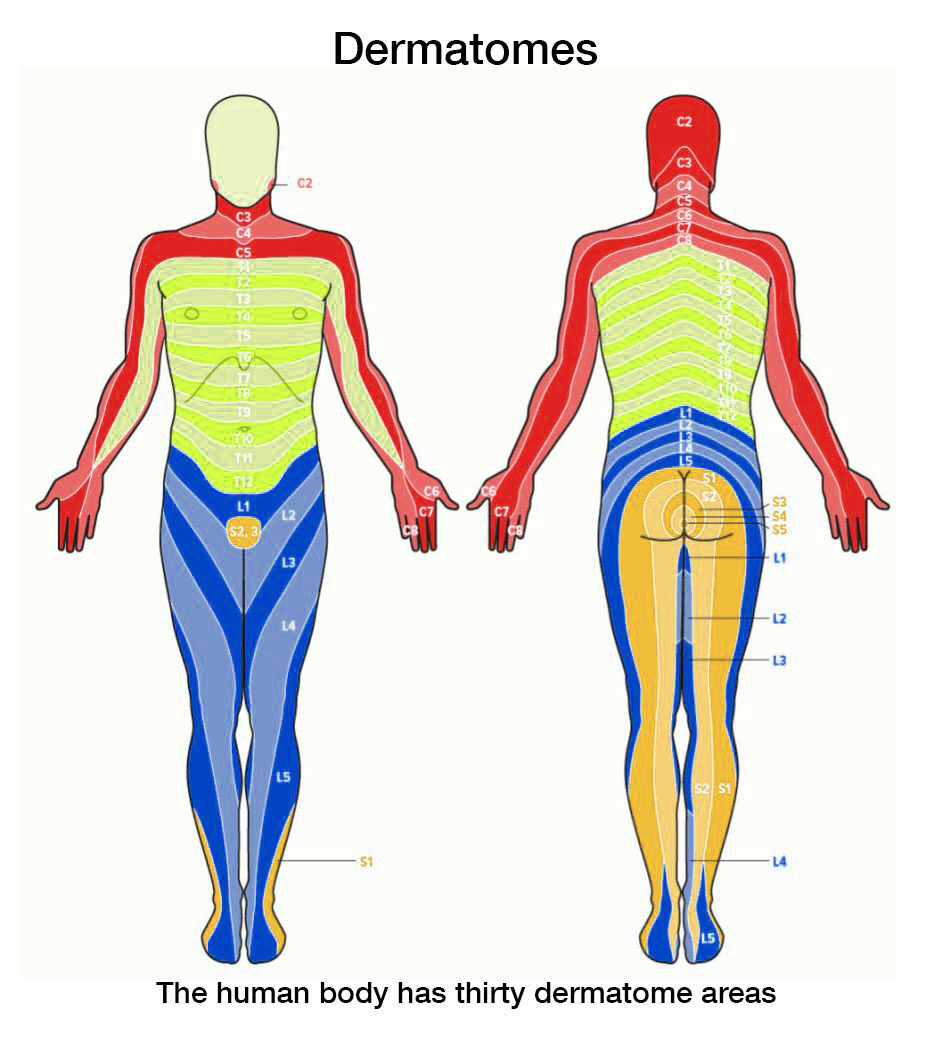1. What is shingles?
Shingles (herpes varicella-zoster) is a reappearance of chickenpox. This often happens many years after the original chickenpox infection. If you think you might have shingles, you should get the antiviral treatment promptly. Click here to read what one lady told us it was like.
Click here to view a video about shingles:
 .If this video was helpful, we’d be very grateful for a donation
.If this video was helpful, we’d be very grateful for a donation
2. What are the signs and symptoms of shingles?
Most often people get shingles on the left or right side of the torso, on a patch of skin served by nerves from a single ganglion (nerve ‘junction box’). This often follows the line of a rib. Sometimes, it will instead appear somewhere else on the face/head or the body.

Red patches are usually the first sign of the rash appearing, and there may also be:
- Itching, tingling or burning under the skin.
- Pain around the affected area, usually on one side of the torso, sometimes elsewhere on the body. This will usually be in one dermatome, which is the area of skin served by one nerve junction. You can see the dermatomes: each is a stripe in the diagram of the body, above.
- Some people may feel very tired or may develop a slight temperature.
- Fluid filled blisters that burst and weep and turn into sores. They may not come up all at once, but form and slowly heal over a period of 2 to 5 weeks. The skin then crusts over and heals, apart from a little sensitivity or ‘nerve ache’ which soon disappears. This may signal the end of the shingles for many people but some people develop post herpetic neuralgia (PHN).
3. How do people get shingles?
When you recover from a chickenpox infection, the virus retreats to a neural ganglion (junction box) in the nerves beside the spine. It remains there in a dormant state for the rest of your life. One day, something ‘triggers’ the virus to reactivate (perhaps when you are run down or unwell, but no one really knows why) and it comes out as shingles.
4. Who will get shingles?
Anyone who has had chickenpox can develop shingles – and most people have chickenpox in childhood: it is one of the common childhood illnesses and is usually trivial. (Chickenpox in adults can be more severe and if they are seen by the doctor within 24 hours of the onset of the rash, they will be given antiviral pills.)
Shingles is more likely to occur in older people.
People who have not had chickenpox cannot develop shingles. (Some people with shingles believe that they have never had chickenpox. This simply means that their original bout of chickenpox was mild and not diagnosed – or they have forgotten because it was a long time ago.)
5. Is shingles common?
About 194,000 people (this is the number for the England and Wales) get shingles every year. About half of these will develop post herpetic neuralgia (PHN).
6. Can you catch shingles? (Is shingles contagious or infectious?)
People do not catch shingles – it happens to people who have previously been infected with chickenpox.
Shingles is infectious for people who have not had chickenpox – but they have to touch the rash to catch the virus. They will then develop chickenpox. People who have had chickenpox already will not be at risk.
When people who have had chickenpox encounter the disease again, it increases their immunity and means they are less likely to develop shingles. So looking after/babysitting children with chickenpox helps prevent your developing shingles.
7. How long do you stay off work with shingles? How long do you stay out of school with shingles?
WORK or SCHOOL: A person can only catch chickenpox by touching the shingles sores, so when shingles is under clothing/ bandage, there is no risk of infection to other workers/students.
As soon as you feel well enough, you can go back to normal life. People ask “How long does shingles last?” but you cannot guess if it will be a few days or a few weeks.
8. Can you get shingles in the eye?
Although very rare, shingles can occur inside the eye. Only one eye will be affected. This must be treated with antiviral medication, as if you don’t treat it the eye may be damaged.
9. Can shingles be treated?
Getting treatment quickly is important. If you can start treatment within 72 hours of noticing the first symptoms (or even sooner), it should reduce the severity of the episode.
The treatment is a course of aciclovir (Zovirax) tablets; or possibly Valtrex (valaciclovir) or Famvir (famciclovir). These antiviral pills do not work for everybody, but prompt treatment may reduce the severity of the episode. This is why it is important to visit the doctor – or chemist, see below – as soon as you become aware of the first symptoms of shingles.
New: you can get antiviral pills for shingles directly from the chemist
Pharmacy First is a new programme that allows a phamacist to prescribe the antiviral pills for shingles without your having to see the GP. Read more about Pharmacy First here.
10. What can I do to help my shingles?
Keep the sores clean, but do not use scented soaps or bath oils and do not rub too hard as this will delay healing. You can sooth the rash with ice cubes wrapped or a pack of frozen peas wrapped in a towel (so as to avoid frost-bite) or a soothing lotion (such as calamine) applied to the rash. Some people have found aloe vera gel gives relief.
Wear loose fitting, comfortable clothes preferably in a natural fibre such as cotton.
You may find vitamins help, especially those related to skin and nerve healing like vitamins A, E and B-complex. Most vitamins depend on a good supply of other vitamins to function efficiently, so make sure your diet contains plenty of fresh fruit, vegetables and cereals. Remember – the skin will heal, so try not to worry.
The ‘Reader’s Tips’ page, which is part of the pack you can buy, gives some other suggestions from other sufferers.
There is a separate webpage about post-herpetic neuralgia (called PHN) – the pain that sometimes continues after the skin has healed.
11. A vaccine to prevent shingles
A new vaccine to prevent shingles which has been introduced. It is offered by GPs to everyone between 70 and 79 – and also as they reach their 65th birthday. (If you are 66 to 69, you need to wait – or buy it privately.)
Ask your GP for the vaccination. This vaccination prevents most cases of shingles, and the cases that do happen in vaccinated people are milder and less painful. Read more about the shingles vaccine programme here.
12. Help the Shingles Support Society
The Shingles Support Society is a sub-group of the Herpes Viruses Association (HVA) a registered charity, offering support to patients. As a voluntary organisation, we depend on your donations to enable us to continue to serve the community – we rely on your generosity.
Please would you make a donation? Any amount will help, no matter how small. Cash or postage stamps, cheques or postal orders (made out to ‘SSS’) will help to ensure our work continues. Click here to find out how to donate. Or you can click through to the shop area here and go down the page to where you can order the full 17-page “Shingles Information Pack” as described above.
Perhaps you would consider making a legacy. Thank you!
Marian Nicholson, Director
13. Bequests
We know that many people leave money to charities in their wills. We would really appreciate it if you would consider this kind of donation. If you already have a will, you can leave something to the Shingles Support Society in a codicil, that is an addition to your existing will. This is easier (and cheaper) than getting a whole new will.
We were left money by Mr Stone, whose son informed us: “My father found the information that you supplied made such a difference to his quality of life in his final years that he wants others to benefit as well.”
Mrs Scott’s church arranged a special collection for us in her memory and donated it to our charity. We were very touched.
Mr Goldman asked the Rotary Club he was very involved with to send the money raised after his death to us. “The Shingles Support Society is my favourite charity” he told them.
As a registered charity (no. 291657) we submit details annually to the Charity Commission so that it can ensure that we are fulfilling our constitutional ‘statement of aims’. You can be sure that your legacy would go to help spread information about treatments for shingles and PHN to everyone who needs it.

This page was written under the Information Standard rules.
Issued on 19/12/2014
Reviewed on 14/02/2025
Full references for the statements made can be sent on request. Send us an email at [email protected].
The Information Standard states: The HVA and SSS shall hold responsibility for the accuracy of the information they publish. Neither the Scheme Operator nor the Scheme Owner shall have any responsibility whatsoever for costs, losses or direct or indirect damages or costs arising from inaccuracy of information or omissions in information published on the website on behalf of the HVA and SSS. Disclaimer: note that the blog and other personal experience stories are excluded from the scope of IS certification.
